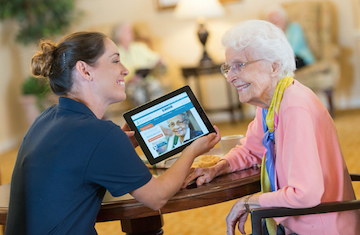
The market for technologies that address healthcare labor shortages is expected to grow alongside workforce challenges and an aging population, according to specialty investment bank Ziegler’s recently published white paper, “Understanding the Technology Ecosystem for Senior Living & Care – Volume 2: An Overview of Workforce Solutions.”
“COVID-19 has forced the smart aging industry to adjust the way it interacts with residents and delivers care,” according to authors Clayton Wilson, a research assistant at Ziegler, and Lisa McCracken, Ziegler’s director of senior living research and development.
“Older adults are rapidly adopting, and gaining comfort with, modern technologies,” they noted.
Among the technologies cited are telehealth offerings, via which residents can connect to medical providers via video or phone and receive care without leaving a facility.
In addition, the authors said, falls detection devices, clinical sensors, personal emergency response systems and other monitoring technologies track key health metrics in real time from remote settings and can help stave off adverse health events.
Smart speakers and voice-activated calling devices that integrate with Skype, FaceTime and other platforms can help residents interact with both staff members and family members outside of a long-term care setting, Wilson and McCracken said. This capability can help prevent feelings of isolation and loneliness, they noted.
“Some of the most innovative providers are also exploring how robots, avatars, and other artificial intelligence software can help engage residents,” they wrote.




